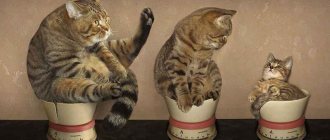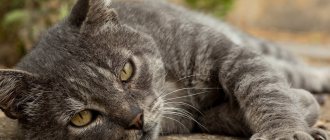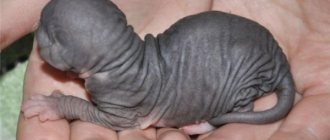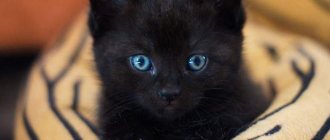How to convert a cat's age to human age
It is worth noting right away that it is unlikely to be possible to accurately calculate how old a cat is in human age. The intelligence and psyche of an animal are structured completely differently than that of a person, so calculations give very approximate results. Of course, animals mature faster than people. A one-year-old child is still a baby by human standards.
A one-year-old cat is a human teenager of 14-15 years old. By this time, the pet has already reached puberty and can get food and take care of itself. The cat has already gone through the process of socialization and knows its owner and family members. Able to avoid danger.
By two years of age, the cat's age in human terms is approximately 24 years.
Males are actively fighting for territory and females, cats are ready for pregnancy and the birth of kittens. Each subsequent year can be counted as four.
Why count and methodology
Animals develop faster than people. There is an opinion that the age of a cat can be compared with the age of the owner by multiplying the number of years by 7. However, this simplified approach fails when applied in practice. A one-year-old cat is not equal to a seven-year-old child. This is a fairly mature animal, ready to reproduce. And the twenty-year-old Murka is not 140, but much less.
The method for comparing the age of the pet and the owner is based on the condition of the teeth. It is known that by two weeks the kitten has incisors, which corresponds to a six-month-old baby. By the 56th day, the cat cub already has 26 dents. From fourteen weeks, teeth begin to change to permanent ones. The process is completed by 6–8 months.
In the first year of life, the psyche of a young animal is formed. According to felinologists, such a cat corresponds to an eighteen-year-old teenager. Experienced breeders have developed a correspondence table that is used to estimate the relative age of the animal.
Calculation by formula
To calculate how old a cat is compared to human age, you can use the formula:
- N=24 + (n-2) x 4, where n is the age of the cat, from which the first two years should be subtracted, equating to 24 years of human life.
- Thus, if the pet is 8 years old, then the cat’s age by human standards will be N = 24 + (8-2) x 4 = 48 years.
Calculation using specialist observations
Many experts are inclined to believe that during the first five years, each year a cat lives is equivalent to 7 human years.
- From 6 to 12 years old, each year a pet lives can be counted as 4 human years, and after 12 years as three human years.
- Using this calculation, we find that an 8-year-old cat lived 5 x 7 + 2 x 4 = 43 years by human standards.
Not a universal formula
Often, pet owners believe the adage that one year of a cat or dog's life is equal to seven years of their life. Unfortunately, this is too simplistic. A cat becomes sexually mature after about 6 months, depending on the breed. According to this formula, the kitten is 3.5 years old, which breaks the theory of 7 years of age. Instead, you'll find that it's quite varied.
First, it is important to consider your cat's age in months when she is under 1 year old. In addition, the numbers also change depending on the stage of the animal's life. Diet and health can also play a role. Keep in mind that cats' life expectancy is not necessarily the same as that of humans.
Calculation method using coefficient.
This method is considered the most accurate, although it is not entirely perfect. To calculate the coefficient, scientists used the physical condition of animals, the level of intelligence, and the level of socialization of humans and cats.
- Although determining the level of intelligence of pets is a very difficult process.
- Some cats have difficulty litter box training, while others can do complex tricks.
- The essence of the method is to calculate the coefficient of correspondence between the age of a cat and a human.
- The coefficient value ranges from 6 to 26 during the first year of life, and then decreases to 7.8 in subsequent years.
On the Internet you can find a table of the age of cats by human standards indicating these coefficients.
Tables of correspondence between cat and human ages
On websites and forums dedicated to cats you can find different tables for converting a cat’s age to a human’s. These are “Comparative table of age correspondence from birth to one year”, “Comparative table of age correspondence from 1 year”.
Data from different sources may differ significantly, as zoologists observed different breeds of cats.
Many factors influence the maturation process of a cat:
- Place of residence;
- Nutrition;
- Breed;
- Individual qualities.
For example, purebred British cats fully mature only by the age of three, and street cats are already fully developed animals by the end of the first year of life.
Growing up and lifespan of a cat
Just like in humans, a cat's maturation goes through several stages. The first stage, “childhood,” occurs in the first six months of a kitten’s life.
- By six months, the cat’s age by human standards corresponds to 7-8 years.
- From seven months to two years, a cat goes through adolescence.
- It is generally accepted that at two years a cat is already a fully formed individual, like a person at the age of 25.
- From three to six years old is the most active age of a cat. She is ready to fight for territory and have offspring.
- During this period, pets are the most vigorous and healthy. For a person, this is the age from 25 to 45 years.
From the age of seven, the gradual process of aging begins. Cats become less playful and sleep more. At this age, it is advisable to regularly take your pet to the veterinarian to prevent diseases that may develop in adulthood. The age of a cat is from 7 to 10 years, which is approximately the age of a person from 45 to 55 years.
- After 11 years, the aging process becomes more noticeable, but a cat is quite mobile until the age of 15.
- The pet's vision deteriorates, and problems with teeth and fur may occur. The cat becomes more lethargic.
- During this period, special attention should be paid to nutrition so that the animal receives all the necessary vitamins and minerals. For a person this is a period of 65-75 years.
In most cases, cats live to be 16 years old, which is 79-80 years in human years. But with good care and a balanced diet, cats can live more than 20 years and die at a very old age.
Science knows the winner of the Guinness Book of Records, a cat who lived for 38 years.
How to extend the life of a pet
Wanting to know the answer to the question of how long a cat's year is considered, the owner is not just showing curiosity. First of all, such data will help prolong the life of your beloved couch potato. In order for a cat to delight family members with its presence for a long time, the owner should know how to prolong the life of a furry pet:
- For each breed, you should follow the advice and recommendations of breeders on.
- Conduct routine vaccination against infectious diseases.
- If an animal is not of breed value, then to increase its life expectancy it should be castrated or sterilized at an early age.
- Regular preventive examinations by a veterinarian allow you to identify diseases at an early stage, as well as adjust housing and nutritional conditions. After 6 - 7 years, the cat should be taken to the clinic every six months, including ultrasound diagnostics of internal organs.
- Feeding your pet premium and super-premium food will prevent the development of many diseases and prolong the life of your furry homebody.
The owner, knowing how to calculate the age of a cat, will be able to avoid many mistakes in keeping a pet. Raising, caring for, feeding, and caring for the health of an animal must correspond to its age, physical and mental condition.
How to calculate how old a cat is? This question may concern many who pick up stray animals or for some reason do not know the date of birth of their pet.
Today, the life expectancy of cats tends to increase and is approximately 12-17 years. Typically, cats living at home live up to 18 years, sometimes more. But cats with access to the street have a shorter life expectancy due to the dangers that may lie in wait for them on the street: cars, consumption of dangerous foods, human factor, etc.
The life expectancy of your pet is influenced by many reasons: heredity, quality of life, including quality of nutrition (read) and in general.
Cats tend to mature quickly. A year after their birth, they are already fully developed and reach sexual maturity. Therefore, compared to humans, cats have an extremely short childhood.
You can understand how to determine the age of a kitten using the following criteria:
Teeth. How to determine a cat's age by its teeth
Teeth are a good indicator for determining the age of a kitten. Baby teeth appear between two and four weeks of age. Later, milk teeth are replaced by permanent teeth, and tooth replacement occurs at the age of about 3-4 months.
By opening your mouth and finding permanent white teeth there, you can say that you have a cat about a year old, maximum one and a half years old. Slight yellowing of the teeth or the presence of tartar indicates an age of approximately 1.5 - 2 years.
The presence of tartar on all teeth is approximately 3-5 years. The absence of teeth in a cat's mouth can indicate a very old age.
However, it should be noted that teeth are not an absolutely accurate indicator of the age of an animal. They may be in poor condition due to improper care of the animal, or, on the contrary, snow-white teeth may mislead you when calculating the age and only indicate impeccable care for the animal.
Here is an approximate list by which, by looking into your pet’s oral cavity, you can approximately determine how old he is:
- 2-4 weeks - baby teeth erupt;
- 3-4 months - replacement of baby teeth begins;
- 5-6 months - complete replacement of baby teeth with permanent ones;
- 1 year - healthy cats have white teeth without much tartar;
- 2 years - the middle incisors on the lower jaw wear away, the enamel turns yellow, and tartar accumulates;
- 3-5 years - the central incisors of the upper jaw, the outermost incisors and canines are worn out;
- 6-7 years - the pigmentation of tooth enamel is disturbed, the outer incisors of the upper jaw are erased;
- from the age of 10, the central incisors begin to fall out, then the middle and extreme ones;
- By the age of 15-18, fangs fall out.
Puberty
If your cat is trying to mark its territory, the urine has a specific strong odor - this indicates that the pet has reached sexual maturity (usually this happens at the age of about 5-6 months). Mature cats become very affectionate and emit loud meows. They go into heat, calling for potential suitors, starting at the age of 5 – 12 months.
Appearance of wool
Younger cats have soft, fine fur. With age, the coat becomes coarser, the color may lighten or, on the contrary, darken. Older animals, like people, have gray hair, individual white or gray hairs, as well as entire spots, may appear.
Eyes
Juveniles usually have clean, clear and bright eyes. With age, you may notice a change in eye color or the presence of clouding, pigmentation disorders of the iris. They are developing.
Lifespan of cats
The lifespan of a cat depends on many factors. Street cats rarely live longer than 7-10 years, as they are forced to look for food, are exposed to danger from people and dogs, and often get sick.
- Breeds that were recently bred through inbreeding usually live 10-12 years. This is due to hereditary and genetic diseases that are common in such animals.
- Breeds whose history goes back several centuries, such as Siamese cats, Persians and British cats, live 15-20 years.
- Outbred pets can live up to 25 years.
Males live two to three years less than females, this is evolutionarily determined by their need to fight for territory and females. An elderly cat can no longer defend its interests.
For owners who are interested in how to determine the age of a cat by human standards, there is a lot of information in specialized literature and on thematic websites.
The choice of calculation method is a personal matter for each furry pet owner. If a cat lives in good conditions, eats properly and undergoes medical examinations, then it can please its owner for many years.
What to do to extend the life of a cat
The owner must take proper care of his pet so that he lives as long as possible. There are several recommendations that are worth studying before getting a kitten:
- Carefully monitor the animal’s diet, try to buy balanced, high-quality food;
- Buy additional special vitamins and nutritional supplements that can prevent vitamin deficiency. These drugs are sold at any veterinary pharmacy;
- Take into account all the recommendations that are related to the peculiarities of caring for a particular breed;
- Play with your pet more often, if possible - let it go for a walk so that the animal can lead an active lifestyle;
- Take care of his health. Be sure to get all the necessary vaccinations, seek help from a veterinarian at the first signs of any illness, keep the bowl always clean, and provide constant access to water;
- Give your animal love and attention, which will definitely have a positive effect on its longevity.











